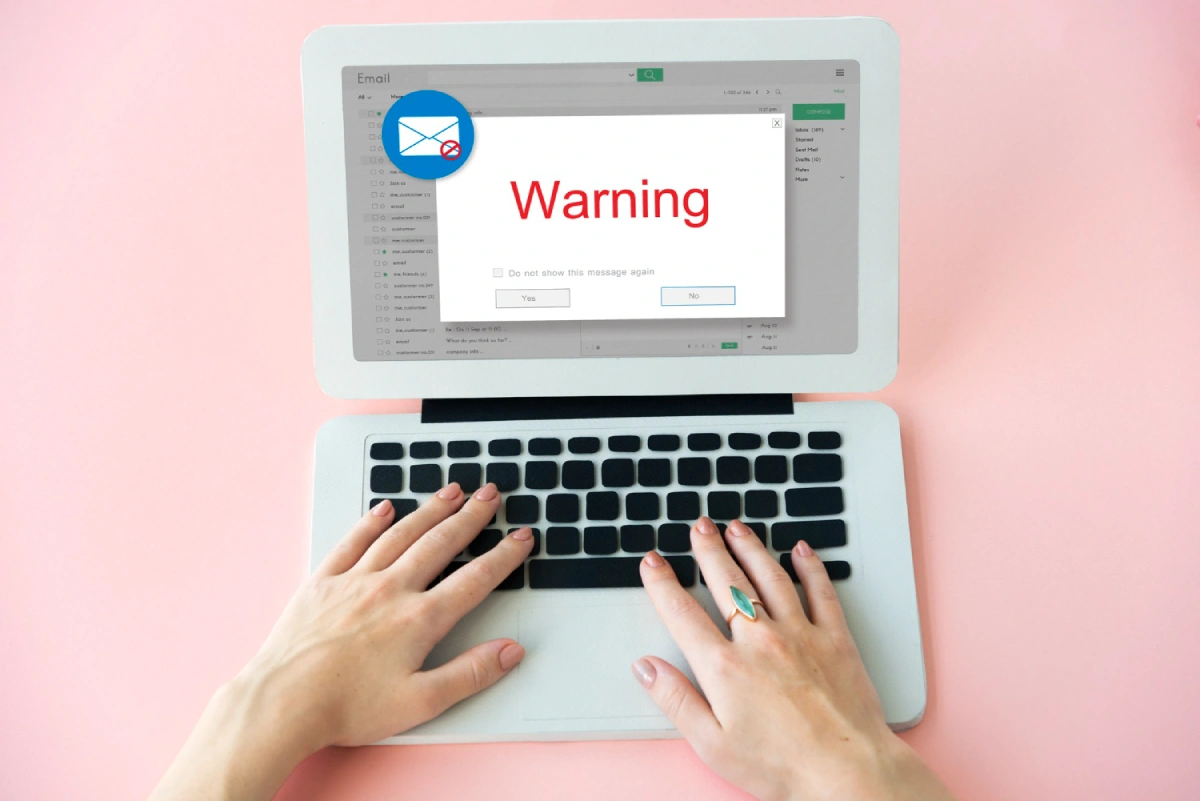

How to Detect and Remove Scam Emails from Your Inbox
Introduction
Scam emails are becoming more common, and it’s not just individuals who are being targeted; businesses are too. With scams constantly evolving, it’s essential to stay ahead of the game and protect your inbox from malicious emails that can lead to big trouble.
This article is your guide to spotting and removing scam emails, whether you're just getting started or already know a thing or two. We’ll cover practical tips on how to detect, prevent, and remove these emails so you can keep your inbox clean and your personal or business data safe.
Stay with me as we dive into how to protect yourself from these digital threats.
Understanding Scam Emails
What are Scam Emails?
Scam emails are fraudulent messages designed to trick you into revealing sensitive information or downloading malicious software. They can look like they come from trusted sources, such as banks, social media platforms, or even friends. However, their real focus is to steal your private data, money, or access to your devices.
Types of Scam Emails
- Phishing: These emails often claim to be from banks or online stores, asking for your login credentials or financial information.
- Malware: These emails contain attachments or links that, when clicked, install harmful software on your device.
- Fake Offers: You might receive emails offering “too good to be true” deals or rewards that ask for personal information upfront.
- Impersonation: Scammers might pose as someone you know, like a colleague or a friend, to ask for help or money.
- SEO Scams: These emails might promise to boost your website’s ranking for a fee, but they are just out to steal your money.
How to Detect Scam Emails: Beginner to Expert
Beginner:
At the beginner level, spotting a scam email is all about recognizing the obvious red flags. Be aware of some basic things:
- Poor Grammar: Scam emails often contain spelling mistakes, awkward phrasing, or incorrect punctuation.
- Urgent Language: Scammers create a sense of urgency with subject lines like “Immediate Action Required” or “Your account has been compromised!”
- Suspicious Attachments or Links: Never click on attachments or links that look odd or unfamiliar. Hover your mouse over the links to reveal their true destinations.
Common Scam Subject Lines and Sender Addresses
Watch out for phrases like "Limited Time Offer!" or "You've Won a Prize!" and be careful if the sender's email doesn't match the official domain (e.g., "support@paypa1.com" instead of "support@paypal.com").
Intermediate:
As you gain experience, you’ll start to analyze email headers and metadata. These are the behind-the-scenes details that can reveal a lot about the email’s legitimacy:
- Email Headers: Check the "Received" field to track where the email came from. If the sender’s IP address doesn’t match the expected location, it could be a scam.
- Spoofed Domains: Scammers often use subtle changes in domain names, such as "amaz0n.com" instead of "amazon.com," to deceive you.
Expert:
If you're really looking to step up your email-detecting game, advanced tools and techniques will come in handy:
- SPF, DKIM, and DMARC Checks: These email authentication methods help confirm the sender's identity. You can use specialized tools to check them if you think an email is fake.
- Behavioral Analysis: Pay attention to patterns in the language, timing, and urgency of the email. Scammers often use social engineering tactics to exploit your emotions, like making you feel guilty or scared.
Whether you're just starting or a seasoned expert, being vigilant about these signs can save you a lot of headaches down the road.
Remove Scam Emails: Step-by-Step Guide
Manual Removal
The first step to keeping your inbox clean is to manually delete scam emails. Here’s how to remove them safely from major providers:
- Gmail: Open the email, click the three dots in the top-right corner, and select "Report phishing" or "Delete." Then, empty your "Spam" and "Trash" folders.
- Outlook: Open the suspicious email, select “Junk” at the top, and choose “Phishing” to report it. Then, delete it and clear your Junk folder.
- Yahoo: Similar to Gmail and Outlook, you can click the three dots to report the email as phishing or spam and then delete it.
Emptying Spam/Junk Folders and Trash
Once you’ve removed the scam emails, don’t forget to clean out your Spam and Trash folders. Scammers can lurk there too, and it’s a good practice to regularly empty them.
Automated Solutions
To save time and avoid dealing with scam emails every day, you can set up automated solutions:
- Spam Filters: Most email services come with built-in filters that automatically send suspicious emails to your Spam folder. Ensure your filters are set to the highest sensitivity.
- Third-Party Anti-Spam Tools: Consider using tools like SpamAssassin or Mailwasher to block unwanted emails before they even reach your inbox.
Bulk Removal
If your inbox is flooded with scam emails, bulk removal can be a real lifesaver. Here’s how:
- Use the “Search” function to find specific scam-related keywords like “prize,” “offer,” or “account verification.”
- Once you have the results, you can select all the matching emails and delete them in one go, without worrying about losing important messages.
By combining manual removal, automation, and bulk actions, you can easily stay on top of scam emails and keep your inbox clean and secure.
Preventing Future Scam Emails
Best Practices
Preventing scam emails from reaching your inbox in the first place can save you a lot of time and hassle. Here are some best practices:
- Never Share Your Email Publicly: Avoid posting your email address on public websites or social media platforms where spammers can easily harvest it.
- Use Strong, Unique Passwords: Create complex passwords for your email accounts, and don’t reuse them across different platforms. This makes it more difficult for scammers to get through.
- Enable Two-Factor Authentication (2FA): Adding an extra layer of security, like a text message code or authentication app, can prevent scammers from accessing your email even if they manage to get your password.
Technical Solutions
For added protection, you can also adjust technical settings to block scam emails:
- Whitelisting and Blacklisting Senders: Keep your contacts safe by whitelisting trusted email addresses. On the flip side, blacklist known spammers to prevent them from getting through.
- Regularly Update Email Security Settings: Email providers often release security updates to counter new threats. Ensure that your settings are always up to date.
- Leverage AI-powered Email Security Tools: Use advanced tools like Google’s Gmail security or third-party options that use machine learning to identify scam emails more effectively.
By taking these steps, you’ll significantly reduce the likelihood of scam emails making it into your inbox in the first place, giving you peace of mind and a more secure online experience.
What to Do If You Fall for a Scam Email
Immediate Steps
If you’ve accidentally fallen for a scam email, don’t panic—acting quickly can help minimize the damage:
- Disconnect from the Internet: Immediately disconnect your device from the internet to prevent any further communication with the scammer’s servers.
- Change Your Passwords: Update your passwords for affected accounts, especially email and banking. Make sure to choose strong, unique passwords that are hard to guess.
- Contact Your Bank or Credit Card Company: If you’ve shared financial information, contact your bank or credit card company right away to report fraudulent activity and freeze your accounts if needed.
Reporting Scam Emails
It’s crucial to report the scam so others don’t fall victim to the same attack:
- Report to Authorities: Depending on your location, report the incident to the FTC (Federal Trade Commission) in the U.S., local cybercrime units, or equivalent authorities in your country.
- Report to Email Providers: Mark the email as phishing in your email provider’s system to help prevent future attacks. Gmail, Outlook, and Yahoo all have built-in phishing reporting tools.
Recovering from Data Breaches or Financial Loss
If you’ve experienced a data breach or financial loss, take the following steps:
- Monitor Your Accounts: Monitor your financial accounts and credit reports for any unusual activity. Services like Credit Karma can help you keep track of your credit score.
- Use a Data Recovery Service: In some cases, if sensitive data was compromised, you may need to reach out to a professional recovery service to secure your personal information.
Though falling for a scam can be unsettling, quick action can limit the damage. The most important thing is to stay vigilant and learn from the experience to prevent future incidents.
Tools and Resources
To help you tackle scam emails more effectively, here’s a list of tools and resources that can simplify the process:
Recommended Anti-Spam Tools
- SpamAssassin (Free): An open-source tool that uses a variety of filtering techniques to catch spam before it reaches your inbox.
- Mailwasher (Paid): A powerful email tool that allows you to preview emails before downloading them, so you can easily delete any scam messages.
- CleanMyMac X (Paid): For Mac users, this tool has a feature to scan and remove malicious emails.
- Barracuda Networks (Paid): A robust solution designed for businesses, offering email protection, filtering, and reporting to prevent scams.
Links to Official Reporting Agencies and Further Reading
- FTC’s Report Phishing: Report here if you suspect a scam email.
- Local Cybercrime Units: Contact your local cybercrime authorities for further assistance.
- Google Safe Browsing: For checking if a website link within an email is safe, use Google’s Safe Browsing tool.
These tools and resources will give you a strong foundation to protect yourself and your business from the growing threat of scam emails
Frequently Asked Questions (FAQs)
How can I tell if an email is a scam?
Look for signs like poor grammar, urgent language, and suspicious links or attachments. If the email seems too good to be true or asks for personal info urgently, it’s likely a scam.
What should I do if I accidentally click a scam link?
First, disconnect your internet connection to prevent further communication with the scammer. Then, change any passwords that might be affected, and report the incident to the relevant authorities or your email provider.
Are spam and scam emails the same?
Not exactly. Spam emails are unwanted messages, often for advertising, while scam emails are deceptive and designed to steal information or money. However, they can sometimes overlap.
Can scam emails infect my device just by opening them?
In most cases, simply opening a scam email won’t infect your device. However, clicking links or downloading attachments from scam emails can introduce malware to your device. Always be cautious with email attachments and links.
These FAQs cover some of the most common concerns about scam emails. If you ever find yourself uncertain, it’s always better to err on the side of caution.
Conclusion
To wrap things up, scam emails are a real threat, but with the right knowledge and tools, you can protect yourself and your business. The key takeaways from this guide are:
- Always stay alert to red flags like poor grammar and suspicious links.
- Regularly clean your inbox, use strong passwords, and enable two-factor authentication.
- When in doubt, report scam emails to the authorities to help prevent others from falling victim.
The best defense is a proactive one, so don’t wait for a scam email to find its way into your inbox. Stay vigilant, follow the tips outlined here, and share this article with friends and colleagues to keep them safe too.
If you found this guide helpful, subscribe for more tips or try out one of the recommended tools to make your inbox even safer!
Related Articles :-
- Marketing Design Essentials: How to Create Visuals That Convert
- Top Market Intelligence Tools to Stay Ahead of Your Competitors
- How to Recover Temp Mail Email Address Step by Step




